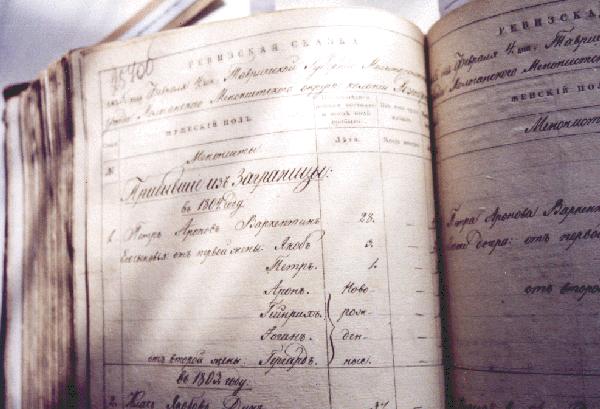As always, a map of Molotschna colony can help us navigate our way (for a larger version, open this link in another tab).
1. 1835 Molotschna census
 |
| Page from the 1835 census. See Ken Ratzlaff website here. |
- Alexanderwohl: 8 (1821)
- Lindenau: 2 (1804)
- Franzthal: 1 (1820)
- Liebenau: 1 (1823)
- Prangenau: 1 (1824)
2. 1847 voting records
As mentioned previously, Molotschna Mennonites elected their own village and district leaders (see further here). Fortunately, the voter list for the 1847 election has survived and provides a record of the 1,075 land owners who cast a vote (only land owners had the right to vote), including 5 Bullers and their villages of residence (for the complete list, see here):
- Alexanderwohl: 3 (1821)
- Friedensdorf: 1 (1824)
- Landskrone: 1 (1839, so after the 1835 census)
3. 1863 grain loan
A severe winter the year before led to a poor harvest in 1863, leaving many Molotschna residents—landed and landless alike—in need of assistance. The colony maintained grain reserves for just such a situation, and the records of the loans of grains made still exists. Of the 1,958 individuals listed, 13 are Bullers (Johann Siebert is also listed):
- Alexanderwohl: 3 (1821)
- Friendensdorf: 3 (1824)
- Gnadenthal: 2 (1862)
- Wernersdorf: 2 (1824)
- Hierschau: 1 (1848)
- Steinfeld: 1 (1857)
- Waldheim: 1 (1836)
4. School registers
In all likelihood, every village school kept records of the students who attended each year, how often they were absent, and if any unusual circumstances attended the student’s performance or enrollment (see previously here). Combing through the available evidence for the years 1853–1884 linked here, one discovers 29 different Buller families (families are identified by father, with the names and ages of children listed after him) and their villages:
- Waldheim: 7 (1836)
- Alexanderwohl: 6 (1821)
- Hierschau: 6 (1848)
- Friedensdorf: 2 (1824)
- Nikolaidorf: 2 (1851)
- Gnadenheim: 1 (1821)
- Gnadenthal: 1 (1862)
- Hamberg: 1 (1863)
- Paulsheim: 1 (1852)
- Rudnerweide: 1 (1820)
- Schardau: 1 (1820)
 |
| Schnurbuch page showing contribution from Peter Buller of Paulsheim. |
5. 1874 Schnurbuch
As discussed earlier here, Molotschna Mennonites formed an aid society to loan funds to those who wished to emigrate to the U.S. but who could not afford to do so. Of the 134 persons listed, 10 bear the surname Buller (4 as contributors and 6 [including 3 widows] as borrowers); 6 of them have a Molotschna village listed:
- Alexanderwohl: 2 (1821)
- Gnadenthal: 1 (1862)
- Hierschau: 1 (1848)
- Paulsheim: 1 (1852)
- Steinfeld: 1 (1857)
6. Alexanderwohl church register
The register first begun in Przechovka, West Prussia, was continued in a new book after the congregation moved to Molotschna colony and established both the village of and a church in Alexanderwohl. That portion of the church register lists 48 Bullers with a birthplace or residence in Molotschna. The distribution of Bullers across the villages is as follows:
- Alexanderwohl: 20 (1821)
- Waldheim: 7 (1836)
- Landskrone: 6 (1839)
- Hierschau: 4 (1848)
- Paulsheim: 3 (1852)
- Friedensdorf: 2 (1824)
- Nikolaidorf: 2 (1851)
- Steinfeld: 2 (1857)
- Gnadenfeld: 1 (1835)
- Mariawohl: 1 (1857)
So, what do we see when we put all these numbers together? First, at least one Buller lived in nearly a third of all the villages in Molotschna—twenty-one out of sixty-five villages. Second, 60 percent of the 114 documented Molotschna Bullers lived in just three villages, and over a third were located in the village of Alexanderwohl:
- Alexanderwohl: 42 (1821)
- Waldheim: 15 (1836)
- Hierschau: 12 (1848)
Third, other villages near the top of the list were located close to the top three, as is evident in the map below, which shows the eight villages with the highest numbers of Bullers (97 Bullers in all).
Clearly, most Bullers were located in the center of the colony, rather close to one another. As we look further for our ancestors, this is presumably where we should focus our search.
Fourth and last, Peter D’s residence in Kleefeld, then Alexanderkrone, then Kleefeld again took him away roughly 6–8 miles from the main concentration of Molotschna Bullers. This coheres with and perhaps confirms our sense that Peter was more closely identified with wife Sarah’s family than with his own.


No comments:
Post a Comment